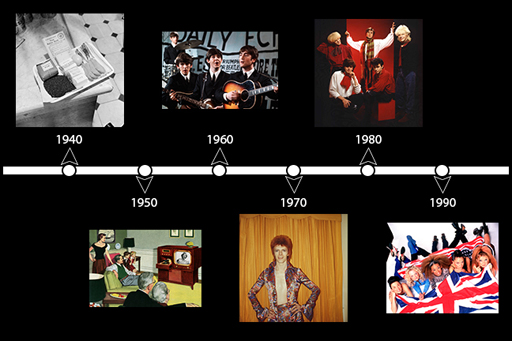4.4.1 Different decades, different returns
The past century has seen several dramatic changes in investment returns over medium- to long-term periods.
Set out in Table 4.6 are 11 periods going back over 100 years. For each of these, the average rate of price inflation for the period is provided and some details are given about the economic conditions prevailing together with other key developments affecting the financial markets.
| Period | Equities (shares) | Bonds (gilts) | Savings accounts | Price inflation (% per annum) | Events and economic background (primarily UK) |
|---|---|---|---|---|---|
| 1903–13 | 1.2 | Period of economic stability. | |||
| 1913–23 | 5.1 | First World War and post-war economic recovery. | |||
| 1923–33 | -2.1 | The 1920s boom followed by the Great Depression. | |||
| 1933–43 | 3.4 | Gradual economic recovery. Second World War and start of active government policies designed to manage economy. | |||
| 1943–53 | 3.6 | End of Second World War and post-war reconstruction. | |||
| 1953–63 | 3.0 | Post-war very steady (generally) economic recovery. | |||
| 1963–73 | 6.1 | ‘Stop-go’ economic policies. Inflation starts to climb. | |||
| 1973–83 | 13.3 | Economic chaos. High inflation, high unemployment, low economic growth. Oil prices surge. Industrial disputes. | |||
| 1983–93 | 5.0 | Inflation falls. Deregulation of financial markets. Privatisation of public utilities. House prices rise and then fall. | |||
| 1993–2003 | 2.6 | Dot-com bubble (and burst). Period of strong growth in economy in personal debt. | |||
| 2003–13 | 3.3 | 2000s boom ends in global financial crisis. Economies struggle to recover and government borrowing soars. |
Activity 4.4 Real investment returns
Have a go at completing the table. Alternatively you can download a PDF version [Tip: hold Ctrl and click a link to open it in a new tab. (Hide tip)] . Using what you have learned so far about the drivers of investment returns, estimate, for each period, whether the real (post-inflation) return for each of the three categories of (UK) investments was positive (‘up’) or negative (‘down’). Note that in each period the direction of return was not always the same for each of the asset types.
Answer
What did you conclude?
The answers are in Table 4.7. Positive real returns are in italic, negative real returns are bold.
| Period | Equities (Shares) | Bonds (Gilts) | Savings Accounts | Price Inflation (% per annum) | Events and Economic Background (primarily UK) |
|---|---|---|---|---|---|
| 1903-13 | 3.3 | -0.2 | 1.5 | 1.2 | Period of economic stability. |
| 1913-23 | -1.3 | -3.1 | -1.5 | 5.1 | First World War and post-war economic recovery. |
| 1923-33 | 9.6 | 9.6 | 5.7 | -2.1 | The 1920s boom followed by the Great Depression. |
| 1933-43 | 3.2 | 0.5 | -2.4 | 3.4 | Gradual economic recovery. Second World War and start of active government policies designed to manage economy. |
| 1943-53 | 2.7 | -2.4 | -2.6 | 3.6 | End of Second World War and post-war reconstruction. |
| 1953-63 | 12.1 | -1.7 | 1.2 | 3.0 | Post-war very steady (generally) economic recovery. |
| 1963-73 | 1.5 | -3.7 | 0.5 | 6.1 | ‘Stop-go’ economic policies. Inflation starts to climb. |
| 1973-83 | 5.2 | 1.9 | -1.3 | 13.3 | Economic chaos. High inflation, high unemployment, low economic growth. Oil prices surge. Industrial disputes. |
| 1983-93 | 12.9 | 7.6 | 5.7 | 5.0 | Inflation falls. Deregulation of financial markets. Privatisation of public utilities. House prices rise and then fall. |
| 1993-2003 | 3.2 | 4.6 | 3.1 | 2.6 | Dot-com bubble (and burst). Period of strong growth in economy in personal debt. |
| 2003-13 | 5.0 | 2.5 | -0.5 | 3.3 | 2000s boom ends in global financial crisis. Economies struggle to recover and government borrowing soars. |
The answers are also in the table to download , colour coded in financial markets style. Positive real returns are blue, negative real returns are red.
Some of the key points that stand out from the data include:
- decades sometimes cover two major swings in economic activity – so it seems that returns are not aligned to the summaries in right hand column
- the reinforcement of the evidence on the outperformance of investments in shares over other asset classes
- the strong link between economic activity and returns on shares
- that shares look like the best bet to beat inflation.
One thing to note, though, is that some of the decades set out above covered periods when there were swings in the level of economic activity rather than one general trend. Consequently for these decades (for example, 1923–33, 2003–13), it may seem that the returns are not aligned to the summaries in the right hand column.

